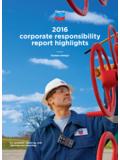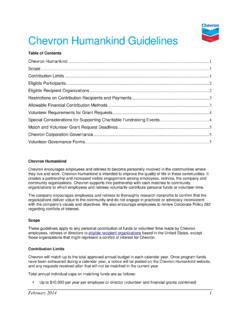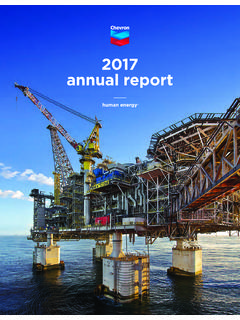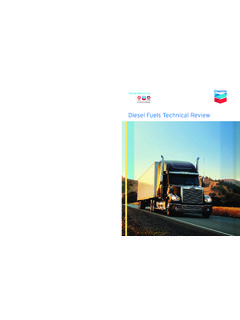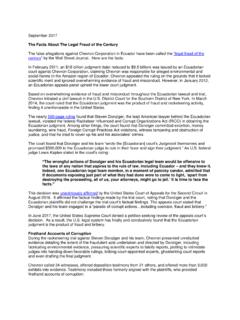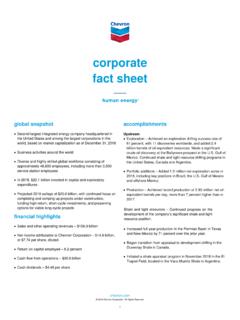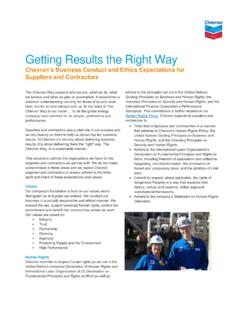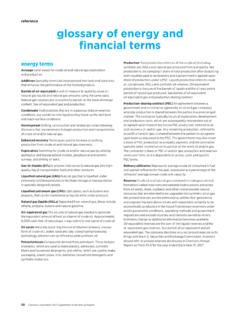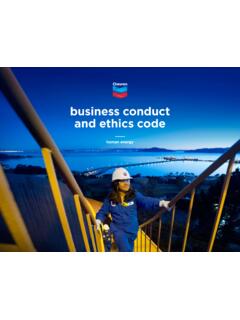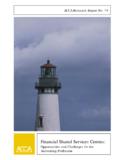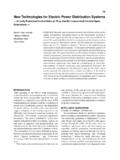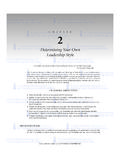Transcription of Operational Excellence Management System
1 An overview for chevron leaders and OE practitionersoperational Excellence Management systemLeft, top to bottom: Workers on a storage tank walkway overlooking Tengiz Field facility in western mariner stands watch on the bridge of one of the company s liquefied natural gas (LNG) carriers. Worker verifying that a pressure relief device is properly tagged, dated and set to the correct pressure at the Pascagoula Refinery, : Workers at the Gorgon LNG facility on Barrow Island, Western of contents1 Chairman s message2 Introduction to the Operational Excellence Management System4 Leadership and OE culture6 Focus areas and OE expectations12 Management System Cycle14 Governance16 Safeguards17 Tenets of OperationWhen we launched our Operational Excellence Management System (OEMS) in 2004, we put in place a comprehensive and prescriptive System to improve our health, environmental and safety performance.
2 The results speak for themselves we ve made dramatic improvements in important measures of personal and process safety, reliability, and environmental fact, on many metrics we lead the industry. We should be proud of our progress in living up to our commitment to protect people and the has given us a solid foundation, but we know there remain areas for improvement. Specifically, we need to eliminate high-consequence personal and process safety events. This means no fatalities or serious injuries and no fires, spills or explosions that can affect people or communities. To achieve this objective, we ve developed the first significant update to OEMS. This update retains many of the core elements of the original, but is simpler in structure and easier to understand. Leaders are accountable for performance and are expected to apply increased focus on three key areas with the workforce: Understand the high-consequence risks that we and our contractors manage every day Clearly identify the safeguards that mitigate these risks Assure that the safeguards are in place and functioning as intendedOur Chevron Way values guide our actions and underpin strong OE performance that is fundamental to our company s success.
3 OE is a competitive advantage in hiring and retaining the best workforce, and vital to building trust with communities and governments. We all have a role to understand and mitigate risks, and to maintain and assure safeguards. I encourage you to read and understand OEMS and to implement it with the passion and commitment I know we ,values Our Chevron Way values guide our actions and underpin strong OE performance that is fundamental to our company s success. Mike Wirth Chairman of the Board and CEO1 Operational Excellence (OE) puts into action our Chevron Way value of protecting people and the environment and helps us achieve Chevron s vision to be the global energy company most admired for its people, partnership and Excellence systematically manages workforce safety and health, process safety, reliability and integrity, environment, efficiency, security, and stakeholders in order to meet our OE objectives.
4 Operational Excellence Management system2safeguardsmanagementsystem cycleleadership andOE culturefocus areasand OE expectationsassurancerisk managementLeadership and OE cultureThrough the Operational Excellence Management System (OEMS), our leaders engage employees and contractors to build and sustain our OE culture and deliver OE areas and OE expectationsFocus areas align with critical OE risks and include: Workforce safety and health Process safety, reliability and integrity Environment Efficiency Security StakeholdersThe OE expectations guide us to design, manage and assure the presence and effectiveness of System CycleThrough application of the Management System Cycle, our leaders make risk- based and data-driven decisions, prioritize activities, and direct managementOEMS is a risk-based and systematic approach to identify, assess, prioritize and manage OE establish and sustain safeguards and assure they are in place and functioning in accordance with legal and OE are the hardware and human actions designed to directly prevent or mitigate an incident or impact.
5 Typical safeguards include facility designs, mechanical devices, engineered systems, protective equipment and execution of the execution of assurance programs, we have confidence the safeguards are in place and objectives The OE objectives set the priorities: Eliminate fatalities, serious injuries and illnesses Eliminate high-consequence process safety incidents and operate with industry-leading reliability Assess and manage significant environmental risks Use energy and resources efficiently Prevent high-consequence security and cybersecurity incidents Address OE business risks through stakeholder engagement and issues management3assessverifymanagesafeguardsr iskassuranceEstablish and execute a safeguard assurance program for high- consequence incidents and impactsVerify and validate that safeguards are in place and functioning Monitor assurance results and address gapsExecute processes and standards with the appropriate level of rigor for the risksFocus on the design, effectiveness and quality of safeguardsMaintain.
6 Access and analyze safeguard performance dataEstablish clear accountability for safeguard performanceUnderstand OE risks, including hazards, potential consequences and the safeguards to prevent or mitigate themReinforce the hierarchy of controls when selecting safeguards Prioritize resources to mitigate risks based on the risk profileeffective leadership is a critical success factor for OE leaders cultivate and drive our OE culture through their values, competencies and behaviorsLeaders must: Build and sustain OE culture Focus on preventing high-consequence incidents and impacts by understanding and mitigating risks and managing and assuring safeguards Define clear OE roles and be accountableleadership and OE culturefocus on preventing high-consequence incidents and impacts by understanding and mitigating risks and maintaining and assuring safeguardsLeaders demonstrate consistent and rigorous application of OE to drive performance and meet OE objectives.
7 The actions and visibility of leaders make evident their genuine care and concern and the company s commitment to place the highest priority on the safety and health of our workforce, and on the protection of communities, the environment and our : Workers review the Preventing Serious Injuries and Fatalities Field Guide during a field walk in the alkylation unit at the Richmond Refinery, and sustain OE cultureOur OE culture is foundational to our business successTo build and maintain this culture across the workforce, leaders need to understand and role-model OE behaviors, including: Focusing their organization on the consistent and disciplined execution and performance of safeguards Instilling and maintaining a sense of vulnerability throughout the workforce Encouraging the workforce to learn by seeking, sharing and integrating knowledge from internal and external sources Encouraging the reporting of incidents, near misses and potential noncompliance, and positively responding to feedback Fostering trust across the company Creating open two-way engagements with the workforce and addressing their concerns Building and strengthening workforce OE culture through the application of programs appropriate for their organization, for example, behavior-based safetydefine clear OE roles and be accountableLeaders have the responsibility to.
8 Provide clear direction on OE roles aligned with We Lead Confirm people are equipped with the technical, functional and OE leadership competencies and skills to execute their OE roles Monitor, coach and hold people accountable on their OE roles Provide resources to effectively and efficiently execute the OEMS Direct and monitor compliance with legal requirements Build partnerships, create alignment and access functional expertiseOperational Excellence Leadership Teams (OELTs) steward the Management System Cycle for their organization. OELTs confirm that the full scope of the OEMS is in the workforce contributes to our OE culture and performance. Everyone has the responsibility to: Maintain a sense of vulnerability Understand the hazards and risks of our work Assure safeguards are in place and functioning Follow required practices and procedures Apply the Tenets of Operation Perform Start-Work Checks Exercise Stop-Work Responsibility5focus areasworkforce safety and healthprocess safety, reliability and integrityenvironmentefficiencysecurityst akeholderscommon expectations Legal.
9 Regulatory and OE compliance Risk Management Assurance Competency Learning Human performance Technology Product stewardship Contractor OE Management Incident investigation and reporting Emergency managementindividual focus area expectations Managing safe work* Occupational hygiene Fitness for duty and worker health* Transportation Codes and standards* Materials and equip-ment Management Process safety information Lifecycle investment analysis* Procedures* Operational readiness Management of change* Well control Well reliability and integrity Asset integrity Equipment reliability Maintenance Environmental Management Environmental information Property transfer* Energy efficiency Resource efficiency and asset optimization Security Management Stakeholder engagement and issues Management Non-operated joint ventures (NOJVs) and third-party aviation and marine activitiesfocus areas and OE expectationsthe OEMS establishes expectations organized into six focus areas aligned to the OE objectives* This expectation applies primarily to its focus area, but may also apply to other focus expectations state the desired outcomes to manage the OE risks.
10 Consistent with company policy and based on identified risks, leaders are responsible for evaluating the applicability, priority and scale of each expectation, and the rigor in its execution. Reporting units are expected to prioritize the execution of OE processes and actions to meet expectations, with increased rigor and focus applied to mitigate high expectations support the OE objective of each focus , regulatory and OE complianceSystematically understand, manage and comply with all applicable health, environment and safety laws and regulations, and OE policy and Identify and comply with internal and external requirementsii. Identify and report noncompliance issues to Management in a timely manner and track corrective actions to closureiii. Enable the workforce to freely and anonymously report existing and potential violations of law and company policy, without fear of retribution or any adverse company action because of reporting.
